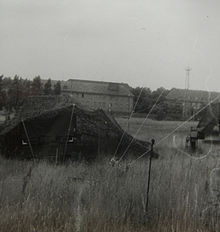RT 415/417

RT-415 in a combat position under camouflage net (NR-14) .
The RT 415/417 directional radio station was a two-wire or four-wire radio station mounted on a Robur LO 2002 box truck (tactically movable) or stationary (RT 417).
In contrast to the Soviet R-404 equipment set, the equipment set was equipped on a semiconductor basis . The station was used in the NVA telecommunications force . The Richtfunktrupp consisted of a troop leader ( NCO ) and three to four soldiers . The rules of the radio relay service were laid down in service regulation DV 040/0/007.
Components
The equipment set consists of:
- 2 radios (only one is used for simple terminal operation)
- 2 multiplex devices (only one is used for simple terminal operation), could be operated remotely from the main station
- 1 monitoring device (for 6 criteria of the radio equipment, battery discharge, power failure)
- 1 power amplifier
- 1 power supply unit
- 1 NF distributor
- 2 filters
- 4 field telephones FF 63 M
- 2 NiCd batteries (up to 16 h operation without mains voltage)
- 2 generator sets
- 3 logarithmic-periodic antennas
- 1 antenna system (located in the single-axle trailer of the RT 415)
Technical specifications
- Number of telephone channels: 5 (one in the original position, four supported)
- Antenna mast height: max. 20 m (only the height required for operation was built up)
- Antenna polarization: vertical or horizontal
- Frequency range: 280 to 328.5 MHz
- Number of radio channels: 98 at intervals of 0.5 MHz (transmitter quartz were carried)
- Intermediate frequencies : 35.25 MHz and 1.7 MHz
- Modulation type : FM
- Pilot signal frequency: 22 kHz
- Transmit power : 0.5 W (8 W with power amplifier)
- Range: 50 km
Procedure for unfolding the station
- Selection of the installation location (sufficient space, favorable sending / receiving conditions, few disruptive factors)
- Construction of the antenna system (three soldiers on the guy ropes, a squad leader on the mast)
- Commissioning of the multiplex device (adjustment of the carrier frequency, system call, level)
- Adjustment of the radio (insert transmitter crystal, adjust power)
- Alignment of the antenna to the remote station
- Activation of the telephone connections (field cable lines)
- Handover of the channels (always with the warning "Warning, you are talking about radio relay!" )
- Pioneering expansion of the news center (space for units, cover for the station, digging out shooting positions)
- Camouflage of the construction site (camouflage net, light and sound camouflage)
- Clarification of the environment (water extraction points, external power supply, create an area map)
- Organization of operations (work schedule, shift and security duty, defense)
literature
- Guide for radio operators. On behalf of the Ministry for National Defense of the GDR, Military Publishing House of the GDR, 3rd edition, Berlin 1976, license no. 5, LSV: 0575

